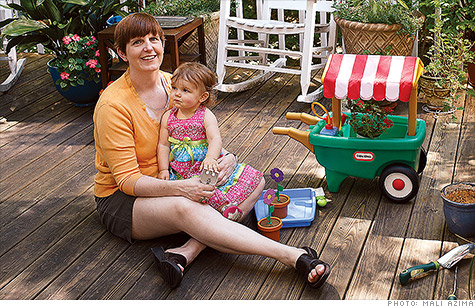Search News

Mary Beth Carr, a single mom, says that paying for her daughter's college education is a top priority.
(MONEY Magazine) -- Soon after her 13-year marriage ended in 2008, Mary Beth Carr had an epiphany: She wanted a baby, even if she had to do it on her own.
Today she's the proud parent of 15-month-old Johnna, whom she had via a sperm donor.
Carr, 43, wants to fully pay for her daughter's college education and to retire shortly after Johnna graduates.
"But I don't have a financial backup," she says. So the Raleigh, N.C., resident, who works as a director at a communications firm, is maxing out her 401(k) and saving in an IRA (she has $271,000 stashed). Plus, she's putting away $200 a month for college.
A good start, but is it enough?
Carr, whose total compensation is around $136,000 a year, will need about $2.5 million in order to cover Johnna's college and retire comfortably at 67.
Charlotte financial planner Ann Reilley Gugle estimates that Carr has about a 60% shot of getting there. Gugle offers advice for improving those odds.
WHERE SHE STANDS
Total assets: $748,700
Total liabilities: $0
THREE FIXES
Get more exposure. Some 46% of Carr's savings is in large-company stocks; 43% is in cash and bonds.
Gugle suggests this mix instead: 33% large-caps, 7% small-caps, 15% international, 29% bonds, 10% alternatives, and 6% cash.
This move alone increases Carr's chances of getting to $2.5 million to 72%, Gugle projects.
Mortgage the house. Carr rushed to erase the loan on her four-bedroom colonial.
Problem is, Gugle says, "almost half her wealth is now tied up in home equity." And real estate historically has returned only a hair more than the inflation rate.
Gugle suggests Carr borrow $100,000 against her home to invest in hopes of better growth.
Carr can easily afford the $477 payment, as much as $333 of which is tax-deductible.
Assuming 7% annual returns on her investment, she'd have about $533,000 in 24 years -- far exceeding the $72,000 in interest on a 30-year loan at 4%; plus, she'll still benefit from appreciation on the house.
Smarten up on college. Carr should up her educational savings to $500 a month.
Also, Johnna's 529 is split evenly between moderate and aggressive age-based portfolios, but Gugle advises Carr to switch entirely to the aggressive one, which invests more in stocks early on.
With annualized returns of 6%, she'll have $184,000 in 17 years, which should come close to covering four years at a state school. ![]()

Carlos Rodriguez is trying to rid himself of $15,000 in credit card debt, while paying his mortgage and saving for his son's college education.
| Overnight Avg Rate | Latest | Change | Last Week |
|---|---|---|---|
| 30 yr fixed | 3.80% | 3.88% | |
| 15 yr fixed | 3.20% | 3.23% | |
| 5/1 ARM | 3.84% | 3.88% | |
| 30 yr refi | 3.82% | 3.93% | |
| 15 yr refi | 3.20% | 3.23% |
Today's featured rates: